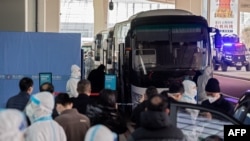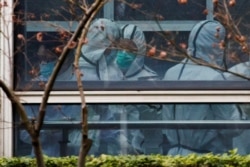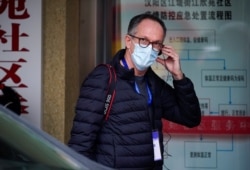This story has been updated to include comment from the New York Times.
On February 12, The New York Times ran an article, “On WHO Trip, China Refused to Hand Over Important Data,” covering a month-long visit by a World Health Organization team investigating the origins of the novel coronavirus, which has killed more than 2 million worldwide.
According to the newspaper, WHO investigators said Chinese scientists refused to share raw data on the initial coronavirus outbreak and that Beijing’s unwillingness to release information was hindering efforts to prevent future outbreaks. The information included blood sample data that could potentially clarify how widely the virus circulated in China in 2019.
The Times reported that Chinese officials urged “the WHO team to embrace the government’s narrative about the source of the virus, including the unproven notion that it might have spread to China from abroad.”
Two members of the 14-member WHO team later disputed the NYT’s characterization of their visit.
“This was NOT my experience on [the WHO] mission,” team member Peter Daszak, a zoologist and parasitologist, tweeted on February 13. “As lead of animal/environment working group I found trust & openness w/ my China counterparts. We DID get access to critical new data throughout. We DID increase our understanding of likely spillover pathways.”
Thea Kolsen Fischer, an epidemiologist on the team cited by the Times, agreed with Daszak’s assessment.
She tweeted that the Times had misquoted them, “casting shadows over important scientific work.”
Asked for comment, a spokesperson for the Times told Polygraph.info:
"Times editors reviewed these concerns and concluded that the scientists were quoted fairly and accurately. We are confident in the accuracy of our reporting."
However, Chinese officials and media outlets attacked the Times for alleged bias.
An editorial on the website of Global Times, the Chinese Communist Party newspaper, said Chinese observers were not surprised by the “baseless report.” The editorial claimed “those in the Western media have insisted on politicizing the virus origins investigation.”
China’s state-run Xinhua news agency said that while “China is committed to transparency and global collaboration in the fight against COVID-19, some Western media like the Times have no qualms about abusing their influence to mislead the public over China out of self-interest.”
The claim that China is committed to transparency regarding the pandemic is misleading. While the veracity of the Times report may be open to debate, Beijing has been at the forefront of a misinformation campaign about the origins of the new coronavirus outbreak.
The 14-member WHO team visited China for 27 days in January and February. A team member, Australian infectious disease expert Dominic Dwyer, appeared to affirm parts of the Times report, telling Reuters that Chinese authorities did not hand over raw patient data on 174 cases from the initial phase of the outbreak.
Among other things, the WHO team was seeking to learn more about spread of the disease before December 2019, when China said it discovered the first cases of infection.
Dwyer said he could not comment on why that information was not provided to the WHO team, but said they “felt that they had received much, much more data” than in the previous year, adding “that in itself is an advance.”
Dwyer told the Australian Broadcasting Company (ABC) prior to the release of the NYT report that he had been “reasonably satisfied” with the information that the Chinese side provided during the visit, but added “you can never be sure of stuff you’re not given.”
“I think some of the investigation around the very early cases was hard to get a hold off,” Dwyer told ABC. “[W]hat you’re really want to do is get details on individual case and go through them rather than just being given the overall results … and there was quite some tension around doing that.”
Meanwhile, Xinhua’s criticism of The New York Times came as the Associated Press and Atlantic Council’s Digital Forensic Research Lab published the results of their nine-month joint investigation, which found China had taken a “leading role” in spreading a coronavirus conspiracy theory that the United States created the virus.
The investigation found that China “embraced overt disinformation” concerning the COVID-19 pandemic while leaning on “Russian disinformation strategy and infrastructure.” AP said the findings were “based on a review of millions of social media postings and articles on Twitter, Facebook, VK, Weibo, WeChat, YouTube, Telegram and other platforms.”
Ironically, the investigation reports that a Chinese citizen was detained and fined for posting a video claiming the virus was a biological weapon engineered by the U.S. Yet six weeks later, China’s foreign ministry repeated the same conspiracy theory, which was “picked up by at least 30 Chinese diplomats and missions and amplified through China’s vast, global network of state media outlets.”
On February 22, 2020, China’s People’s Daily ran a report suggesting the U.S. military may have brought SARS-CoV-2, the virus that causes COVID-19, to Wuhan, China.
On March 12, 2020, Zhao Lijian, China's foreign ministry spokesperson, repeated that conspiracy theory, tweeting: “It might be US army who brought the epidemic to Wuhan. Be transparent! Make public your data! U.S. owe us an explanation!”
That same day, Zhao tweeted a link to an article posted on the conspiracy website Global Research, which falsely claimed the virus may have originated at the U.S. Army biological laboratory in Fort Detrick, Maryland.
As Polygraph.info previously reported, Global Times’ website has repeatedly attempted to connect the COVID-19 coronavirus pandemic to the U.S. Army installation.
Apart from conspiracy theories, the Chinese government’s official COVID-19 timeline has also been undermined by scientific reports.
In addition, several Chinese citizens have been arrested for reports or social media posts documenting the COVID-19 outbreak.
On December 28, 2020, a court in Shanghai sentenced citizen journalist Zhang Zhan to four years in prison for her reporting on the initial COVID-19 outbreak in Wuhan.
The most famous case was that of Li Wenliang, a Chinese whistleblower who warned fellow doctors in early December 2019 about a SARS-like virus in Wuhan.
After sounding the alarm, Li was interrogated by security officials, who made him sign a confession for "publishing untrue statements about seven confirmed SARS cases at the Huanan Seafood Market.” Li died in February 2020 after treating a patient infected with COVID-19 at Wuhan Central Hospital.
Li’s death sparked grief across China and outrage over censorship in the country.







